In and Out of Africa
Close Encounters of the Animal Kind
On the Kenyan side there was a long queue of trucks, which we drove past and went straight into customs. There were two cells at this border post, one for males and one for females. A very miserable looking man was incarcerated in the 'male' cell. We didn't wish to dwell for long on either his crime or his punishment.
In less than an hour we passed through both border posts and were in Kenya. The villages here had a familiar air about them. Much like small towns in Europe or New Zealand. The buildings were square solid constructions and many of the people, especially the men, wore 'western' style clothes. We kept passing men riding bicycles with their wives sitting on the crossbar. This was a noticeable contrast to many of the other countries were men and women seemed detached from each other. The roads were slightly potholed tar seal, again with toll booths to pay for the maintenance. In one place the road was being repaired and we followed the diversion signs with suspicion. Usually diversion signs would continue for several kilometres out of our way and then disappear leaving us stranded in the middle of nowhere. After nearly an hour of following diversion signs we were beginning to get very nervous. It was with surprise and relief that we eventually came back to the main road and an unexpected sign saying 'diversion ends'.
 |
| A snake |
|---|
Our destination tonight was a campsite near Kitale where we hoped to relax for a few days. We arrived with perfect timing just before dark. The surroundings were very restful with lawns and trees and a new shower and toilet block. An ideal place to stay and relax, unfortunately the owner was going to Nairobi in a couple of days and would be closing the campsite so our time would be limited after all.
In the morning we went into the town of Kitale in an attempt to buy spares for the Landrover. This was very much like a small town in New Zealand, wide roads, a remarkably modern bank and small shops with goods on the shelves (biscuits, cheese, chocolate - yum)! There was even a small, well set out museum with a little nature trail and some concrete compounds with animals in. This museum was described in 'Shoestring' "Perhaps the most enjoyable parts...are the nature trail through a remnant of rainforest and a compound full of copulating tortoises". For once 'Shoestring' was completely accurate. The rainforest was enjoyable and the tortoises were certainly copulating. Obviously this is all they do! They were making remarkably human sounding groaning noises and didn't mind being photographed from the side but when I moved round for a close-up of the expression of reptilian ecstasy he became shy and stopped. The other compounds held snakes and crocodiles, although the crocodiles were so inert I think they were stuffed.
We managed to get some new brake pads and brake fluid but not the other part I wanted. Back at the campsite I replaced the pads and overhauled the broken valve. It looked in perfect working order to me. It is only a piston and two rubber 'O' rings so it was difficult to see what could be wrong. After bleeding the air out of the brakes for the first time in days the little red light didn't come on when I pressed the brake pedal. Fiona made an excellent pineapple crumble in our portable oven and we both felt a lot more relaxed by bedtime.
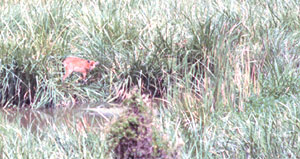 |
| Sitatunga |
|---|
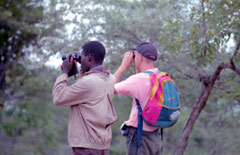 |
| Birding |
|---|
On the way back from the escarpment the brake warning light started to come on again. Now the front brakes seemed to be working in preference to the rear brakes, which is at least an improvement. I was beginning to get more than a little frustrated with the brakes by this time.
In the evening we spent some time with a couple who had been working for ICL in Kenya. This was their final trip before returning home and they were visiting the few game parks they hadn't seen yet. They had been visiting the game parks at local resident prices, which had made them very cheap. In Kenya the game parks have two price structures. The price for locals and residents was just under a third of the price for foreign tourists. This is part of the initiative to increase wildlife and conservation awareness in the local population. Since Richard Leakey has taken over control of the Kenyan wildlife parks the entry price has in general gone down for both tourists and locals. He has made a point of running the parks efficiently, using the revenue for conservation and park management and refusing to pay many of the bribes previously considered normal. As a consequence, even though the prices have gone down, more money is being spent on ensuring survival of the animals. When we discovered this we felt a little happier about paying the relatively high entrance fees. By the end of the evening we had the inside story on Kenyan wildlife parks and our next destination, Rogers camp on the shores of Lake Baringo. "and you've just 'got' to go to Rogers camp". "Why", we asked. "Hmmm, just, go there and you'll find out". No matter how hard we tried we couldn't extract the secret of Roger's camp from them. We really had no choice now, we 'had' to go to Roger's camp and find out.
Kitale is on the central African continental plateau. Running down the East of Africa, from the Djibouti to Mozambique, is a huge and enigmatic geological feature known as the African Rift Valley. It forms a deep scar averaging 50 km across and 600 m deep across the continent. It is one arm of a triple point, an attempt by the forces of nature to split Africa away from Europe and allow it to take it's own course across the oceans. In a bitter twist of irony, geologically, as well as politically, Africa has not managed to escape the influence of the great Eurasian continent. The Rift Valley and Red Sea have stayed virtually unmoved whilst the Atlantic has opened from nothing and the Mediterranean has all but closed. Our ideal route through Africa would have been to drive from Egypt, along the edge of the Red Sea through the Sudan to Djibouti and drive down the Rift Valley past the soda lakes and sodalite volcanoes to Mozambique. Past the sites of mankind's ancient and very ancient past. Africa's recent past has been one of wars and rumours of wars. The history of recent African tourism is one of avoiding wars and rumours of wars. We prudently decided to continue that trend.
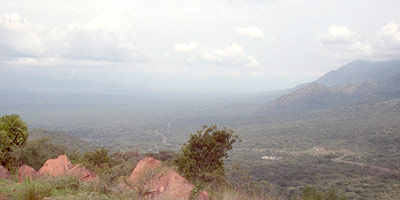 |
| The African Rift Valley from Iten |
|---|
At the edge of the town of Iten we found ourselves perched on the edge of the Rift Valley. In any modern western country you would expect a viewpoint with a shelter and car park. We pulled into the car park at the viewpoint and stopped. Each of us has a different set of experiences from which we view the world. A world which has many beautiful views. There are a very few places which can redefine your expectation of natural beauty. There are a few, very few moments when you turn a corner and, mouth agape, your vision of the world is expanded and changed forever. This, for me, was one of those moments. We were standing at the edge of a 500 metre sheer cliff. From this height, in the haze on the horizon, we could just see the cliffs on the other side. The earth had been literally stretched apart and a section 50 km wide had dropped over half a kilometre towards the centre of the earth. In the distance, at the base of the cliff, we could vaguely make out the road. The magic of the moment was tempered by the knowledge that, very soon, we would be driving down to that road in a Landrover with defective brakes.
The road to the base of the cliff had switch backs which would make an alpine driver despair. I engaged the lowest gear I dared and set off down. By the rest stop half way down the brakes, or perhaps my nerves, were beginning to smell. We pulled in to the halfway viewpoint. The smell of burning brake linings became stronger as a pair of mini-buses with a party of Rotarian tourists pulled in behind us. The concept of engine braking had never been explained to the minibus drivers. As they came to a stop clouds of smoke came from their sorely abused brakes. There was still the same vertical distance to go before we would again be on the flat.
When we reached the valley floor I drove steadily and slowly avoiding the brakes for as long as possible to give them a chance to cool down. We drove steadily to Lake Baringo pausing only to push a local Matatu (taxi) which had stopped in the middle of a ford and wouldn't start again. Using the bull bars we started pushing them the 5 km towards town. After about 3 km they finally managed to start the engine and carried on under their own steam, the back end of the Matatu slightly the worse for wear.
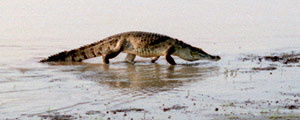 |
| Crocodile |
|---|
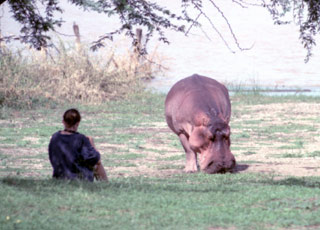 |
| Fiona and Hippo |
|---|
The hippo is a peaceful herbivore. It is also very large and has a powerful mouth with fearsome teeth. When disturbed it uses it's power to great effect and without remorse. It is by far the most dangerous African animal in terms of human fatalities and all of these occur when man enters the hippo's domain. In the night time the campsite belongs to the hippo. It is recommended that you don't get between a hippo and the water, shine torches or car headlamps at them and you should definitely not take flash photographs. This made going to the toilet in the night an 'interesting' experience. If you took your torch and shone it inadvertently at a hippo it might charge and gore you to death. If you didn't take your torch and walked into one by mistake... Fortunately they are extremely loud eaters and neither of us walked into one in the dark. The toilets, once you had got past the hippos, were basically a large wooden box over a large pit in the ground. This was very well disguised and the building they were in was clean with electric lights and white plastic seats. There were also sinks with running water. Luxury indeed for African toilets.
This campsite was full of a cosmopolitan mix of people, from the British Geological Survey to an overland tour truck, the locust eradication project (complete with helicopter and lethal insecticide spray) to tourists who had flown in from Britain this morning. The Geological survey people were off surveying somewhere and the locust people flew off at dawn and flew back mid afternoon and kept to themselves. The blue tour truck looked familiar and it turned out to be the truck we had met at Tamanghasset in Algeria. To be more accurate it was the same company and same passengers. The truck itself had been replaced when their original truck had literally split in half. Their driver had caught malaria and something had happened to the courier (who couldn't drive anyway). Fortunately Trev the easy going Australian, could drive and repair trucks otherwise they would still have been in Zaire. They had taken roughly the same amount of time to get here, although they had taken a couple of short cuts and had fewer rest stops. Trev told us all their adventures, they were the people who took the pirogues with Eric and Brian. At the mention of Eric and Brian three English girls rushed over eagerly to ask if we had seen them recently. It seems that as soon as they had caught up with the truck and used up their supply of petrol they had shot through to the coast leaving the girls behind. They seemed to be hoping that they would miraculously return. I doubted that this would occur but kept my thoughts to myself.
There were also some tourists from England and Japan sleeping rough in tents. It was probably the first time under canvas for any of them. Fortunately there were two locals with the truck who cooked all the meals and put the tents up every night. For one woman this was her 40th birthday present from her husband and she was very excited. She thought the toilets were rather primitive. "Did you see the size of the bug on the wall!", she said. At least there was a light to see it by! When I was in the toilet I noticed there was indeed a fairly large insect on the wall. I also noticed a little gently moving hair like thing poking out from under the seat. Curiously I lifted the seat and was not surprised to see about twenty large cockroaches sheltering in the dark space under the lid. I never did tell her about that. She was undoubtedly having the time of her life and would retell stories of that insect with as much gusto as Manuel will talk about his tape worm.
As the afternoon drew to a close I was standing near the water's edge. The Japanese tourists walked up and asked me if there was any wildlife around. "Well, there are crocodiles". At which point the crocodiles hauled themselves out of the water onto a little sandbar. "And at about this time one of the hippos usually wanders out of the water to graze around the campsite". They were looking at me a little suspiciously when, in the best David Attenborough tradition and perfectly on cue, the hippo walked out onto the land and started to graze. The Japanese tourists now thought I was some kind of wildlife expert. They also assumed the hippo must be tame and the man directed his wife and daughter to stand closer to the hippo while he started taking flash photographs. "I don't think you should do that ". I said. He continued taking snaps while I retreated to a safe distance, my own camera ready for that prize winning photograph. In spite of their complete lack of comprehension that these animals were wild and potentially dangerous, they didn't get trampled by the hippo or eaten by the crocodile. This was fortunate as something like that could have really ruined their holiday.
All too soon we felt the need to leave. There seemed to be something driving us. Perhaps it was anticipation that the next place would be somewhere we could stay for weeks, perhaps a desire for working brakes, excitement at the prospect of more wild animals, fear of running out of money or just that we were weary travellers longing for the trip to end. Whatever the reason we were proceeding with a decidedly un-African haste.
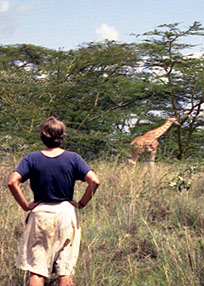 |
| Fiona and a Giraffe |
|---|
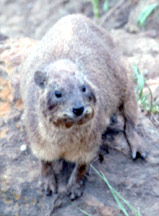 |
| A vicious wild animal |
|---|
Apart from that painful reminder that we were in a game park surrounded by wild animals the day was successful and we finally camped by a picturesque, if slightly muddy, waterfall. We were allowed to camp within the park boundaries as long as we stayed at one of the official spots. This was the most remote and quietest. We shared the spot with an English couple who were working in Nairobi. They tried to get out of the city every weekend to one or other of the nearby parks.
The evening was cool and we needed to wear sweatshirts for the first time since Algeria. Some warthogs wandered into the campsite, waited until we had almost got the camera out and then, tails high, disappeared into the bush. The English couple told us that the best time to see leopard and rhino was in the early morning.
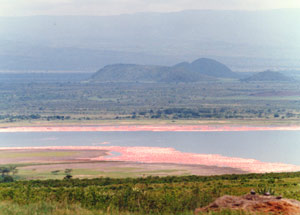 |
| Lake Elmenteita and the missing flamingoes |
|---|
It was Sunday and the campsite at Lake Naivasha was close enough to Nairobi for weekenders. This meant we had to contend with over loud transistor radios for the first time in months. We hoped that they would be returning to Nairobi that evening. There was also a Land Rover and a Range Rover parked nearby so we went to talk to the occupants. They were a couple of white Kenyan's called Joss and Lucy. When we told them we were planning on staying at Ma Roache's campsite (the only campsite in Nairobi) they asked us to stay with them. They would also be able to help us with getting the truck back to working order.
When they left for Nairobi we carried their fire, embers and all, over to our camp and used it to cook a rather nice doughnut shaped quiche. The noisy youths also left for Nairobi and the campsite became peaceful at last.
We spent the morning in the little township of Naivasha. All around there were people leaning imperiously against walls or drinking coffee outside the cake shop. There was an air of self absorption about these people, something which made us nervous. Then we realised what it was. They were white and middle class. After three months in Africa it was the white people who appeared sinister and unfamiliar.
The New Zealanders at Lake Baringo had recommended Elsa Mere as having the best value food in Kenya. A smorgasbord lunch in pleasant surroundings by a small soda lake. This had been built as the retirement home for Joy Adamson who wrote the 'Born Free' books about the Lioness Elsa and her family. The house and grounds had been named after Elsa the Lioness and would have been a wonderful place to retire. Unfortunately she was murdered by poachers before she had a chance to enjoy it. The meal was excellent and it was wonderful to relax by the lake with the rare black and white colobus monkeys climbing around in the trees above us. We spent the whole afternoon there watching the video about Joy Adamson and learning about conservation in Kenya from the people running the Mere. In turn they were interested in New Zealand, conservation, life style etc. They had been in Kenya long enough and were thinking of moving to New Zealand. After six months away we were more than happy to talk about home. By the time everyone's questions had been answered it was 17:30 and would soon be dark. It had been a long peaceful and enjoyable afternoon and they didn't even charge us for lunch.
The next morning we decided not to make breakfast. Instead we would follow the example of the local white people and have coffee and cakes at the little coffee and cake shop in Naivasha. Unfortunately the coffee shop closes all day on Tuesdays. Hungry and disgruntled without our required daily intake of coffee, we headed straight for Nairobi. Fortunately the roads were rather good by African standards and it didn't take long to get there. Our first stop was the American Express office, where we had arranged to receive our mail. Our first mail drop in Cameroun had been a disaster, leaving us feeling very alone and forgotten. This time there were several letters from various friends and relatives. Parked just around the corner and spent the next hour reading letters. The letters were full of surprises. One friend spent one page describing his new job earning huge amounts of money, his marriage, new house, fully restored classic TR4 etc. The next page had a small questionnaire. 'The above was
- Completely true,
- Slightly exaggerated,
- Only partly true,
- a pack of filthy lies.
We took it in turns reading the letters. Fiona was reading one of the letters and commenting "Oh no, that's a shame"..."They haven't!"..."He hasn't"..."WHAT!! With WHO!!! I don't believe it!.". Obviously a lot had been going on at home in our absence. Even though some of the letters were over a month old we felt in touch with the outside world again.
Then we rang Joss and arranged to meet in a shopping centre. This proved to be more difficult than anticipated. Nairobi is in many respects like a modern city anywhere with too much traffic and too few road signs. Surprisingly there were several shopping centres dotted about. We picked the wrong one. It didn't seem to have quite the right shops. We asked one man who said "Yes, this is the place". We asked another man, "No, it is not, I think it is that way". Eventually we did find the shopping centre and Joss. Unaided we would probably never have found his house though, which was down some very windy yet familiar looking lanes. If it hadn't been for the potholes and the occasional tropical trees we could easily have been in England. The house was fairly large with some servants, some large dogs and a 'pet' pig. In the garden there was an avocado tree, before leaving we 'picked' some avocados. This entailed one of the guys shinning up the tree (they wouldn't let me go up) and the rest of us standing underneath with a large blanket to catch the fruit as it fell. I think being up the tree was probably safest. A fully grown avocado, falling from 10-15 metres is a missile well worth avoiding. Fortunately no one was hit and we had plenty of avocados to keep us going.
Joss took us back to the shopping centre to buy some new 'O' rings for the faulty brake component. It was almost like a small shopping centre at home and had a wide range of shops, from tropical fish to automotive accessories. Compared with anything we had seen since France this was shoppers paradise, although Cameroun comes a close second.
The 'O' rings didn't fix the braking problem. Joss thought the engine sounded in need of the tappets set and the injectors cleaned. I had always intended to get this done in Kenya. Financially it was a burden we could do without. We decided to get it done, perhaps the Landrover people here could diagnose the brake problems too.
The injectors did indeed need a good clean and one of them was cracked. This cost much more than we expected, although still probably less than it would have done in England. This meant that we couldn't afford to phone home or eat out at the notorious 'Carnivore' restaurant, where all manner of game meats were available (plus a vegetarian menu!). The brakes still didn't work properly, which was becoming a major issue for me. When I say they didn't work, what I mean is that the little red warning light came on and we had to bleed the air out of the system every couple of days. Other than that they probably worked significantly better than the brakes on 90% of the surrounding vehicles so perhaps I was worrying over nothing. At least the engine was running more smoothly and quietly than it had since England. The fuel consumption also improved and it was probably using less fuel than when we bought it. This was an engine which seemed to thrive on constant hard use.
Joss and Trudy made us very welcome, they even offered us the use of their beach house in Mombasa. Which was very tempting but didn't seem to fit into our master plan. All too soon we were once again on the move, pausing briefly at the American Express office for one last chance at new mail. There wasn't any so we left a forwarding address to the American Express office in Johannesburg. Although we had been very glad of the mail we received we were a little disappointed that some people hadn't sent us any mail. A year later the last piece of mail was returned to sender, all the people who we had expected to write had in fact done so. Some of those letters had ended up better travelled than us. Ironically one, which was returned a year later, was stamped as received in Nairobi two weeks before we arrived.
We had been on sealed roads for almost two weeks now and decided it was time for a short cut. This time our shortcut was marked on the map and still existed. The road was a good one and would also take us as close to Mount Kilimanjaro as we could get. For the first time we saw animals on the side of the road which were not within the confines of a park or reserve. There were zebra and our first wildebeest. Legend has it that when God had made all the animals he had a few pieces left over and used them for the wildebeest. They did indeed look like they had been made from spare parts and they look a bit like a cross between a cow and a buffalo with a bit of horse mixed in. In fact, although this seems as unlikely as the hyrax being a relative of the elephant, they are a type of antelope. Between the herds of zebra and wildebeest the elegant Masai people in flowing purple robes were herding their cattle. Sadly this kind of co-existence between native animals and man seems rare in Africa. In all too many places the only animals you see are the sheep-like goats, goat-like sheep or cattle. The native animals have been driven off the land to make way for crops and herd animals, which in many cases, are poorly adapted to African conditions.
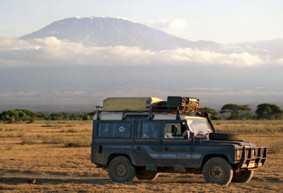 The destination for this evening was Leopard Camp, which had been recommended to us. This was a very well run establishment with that mix of rustic adventure charm and creature comforts. It was in a small area of sheltered bush by a river and there were several 'permanent' tents and a small bar. There was hot running water heated in 200 litre drums over an open fire. There was a shower block next to the drum. The water was also piped to the permanent tents, which were more like canvas houses, with proper beds and built in shower units! There was also a 'hide' where you could watch the leopard come to eat chunks of meat left out for it. Unfortunately they wouldn't be putting any out tonight. To add to our disappointment Kilimanjaro was covered in cloud. "Yes, it is always like that", the owner said, "The cloud is usually gone just before sunset or just after sunrise". It was nearly sunset so we headed off. Miraculously the clouds parted revealing Kilimanjaro in all its majesty. Its highest peaks covered in snow even here, only three degrees below the equator. At 5895 metres this was hardly surprising, although even here on the plateaux we were over 1000 metres above sea level. We spotted some giraffe and drove towards them for the 'official' photo of Kilimanjaro with giraffe in the foreground without which no trip to Kilimanjaro is complete.
The destination for this evening was Leopard Camp, which had been recommended to us. This was a very well run establishment with that mix of rustic adventure charm and creature comforts. It was in a small area of sheltered bush by a river and there were several 'permanent' tents and a small bar. There was hot running water heated in 200 litre drums over an open fire. There was a shower block next to the drum. The water was also piped to the permanent tents, which were more like canvas houses, with proper beds and built in shower units! There was also a 'hide' where you could watch the leopard come to eat chunks of meat left out for it. Unfortunately they wouldn't be putting any out tonight. To add to our disappointment Kilimanjaro was covered in cloud. "Yes, it is always like that", the owner said, "The cloud is usually gone just before sunset or just after sunrise". It was nearly sunset so we headed off. Miraculously the clouds parted revealing Kilimanjaro in all its majesty. Its highest peaks covered in snow even here, only three degrees below the equator. At 5895 metres this was hardly surprising, although even here on the plateaux we were over 1000 metres above sea level. We spotted some giraffe and drove towards them for the 'official' photo of Kilimanjaro with giraffe in the foreground without which no trip to Kilimanjaro is complete.
By now Fiona was becoming as adept at spotting game as I was at avoiding potholes (and other road hazards). "I think there's a cat under that tree!", she said. I stopped the truck gently. For what seemed like an eternity we were surrounded by the inevitable dust cloud. By the time this had cleared any interesting animals had usually run away and it seemed unlikely that it would be still there, if indeed it was more than a shadow. The dust finally cleared and there, lying down under a tree, was a large cat like shadow. The binoculars revealed a large spotted cat. "I think it's a Cheetah", I said giving Fiona a kiss. A quick look in our book of African animals confirmed this. One of the locals from the campsite rode up on his bicycle. He was on his way home for the evening. "What can you see?", he asked. "It's a Cheetah!", I reply. "No, it can't be", he replies shaking his head. I passed him the binoculars. He focused on the shadow and his face turned into a wide African smile. Eyes gleaming he said, "It is a Cheetah!". He had lived all his life here and had never seen one before. He rode off on his bicycle unconcerned and the Cheetah lazily walked off into the bush. We drove back to camp and celebrated this momentous piece of carnivore spotting by spending our last 20 Kenyan Shillings on a Coke each.
Once again we were up early and drove the last, bumpy 25 km to the Border at Oloitokitok. Kilimanjaro, still temporarily clear of cloud to our right. This was a quiet and rarely used border post and the guards seemed surprised to see anyone so early, especially a couple of white tourists. This must have been the fastest border post yet, they barely even looked at our passports. The Tanzanian side would take a little longer.



